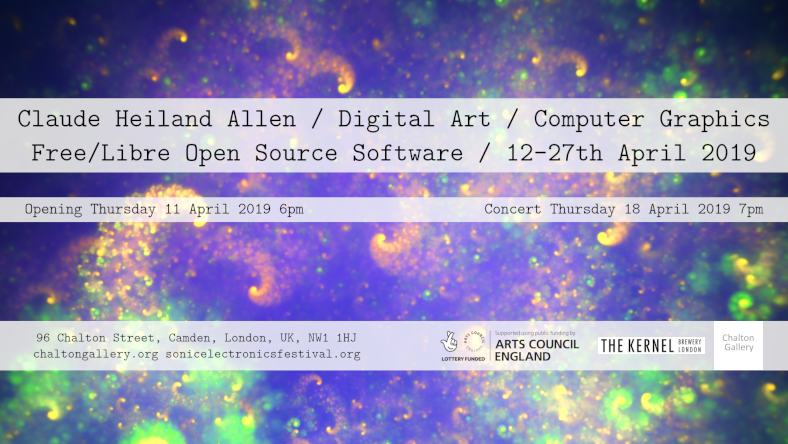Exhibition (Chalton Gallery, London)
I have an exhibition coming up April 2019 in London, UK.
Claude Heiland-Allen
Digital Art - Computer Graphics - Free/Libre Open Source Software
Chalton Gallery, 96 Chalton Street, Camden, London UK NW1 1HJ
Opening Thursday 11 April 2019, 6pm.
Concert Thursday 18 April 2019, 7pm.
Exhibition opens 12-27 April 2019.
Tuesdays: 8 am to 3 pm
Wednesday to Saturday: 11:30 am to 5:45 pm
Prismatic (2015)
Digital print 120x60cm, framed

Prismatic is rendered using a physics-based ray-tracer for spherically curved space. In spherical space the light ray geodesics eventually wrap around, meeting at the opposite pole to the observer. To compound the sphericity a projection is used that wraps the whole sphere-of-view from a point into a long strip.
The scene contains spheres of three different transparent materials (water, glass, quartz) symmetrically arranged at the vertices of a 24-cell. The equatorial plane is filled with a glowing opaque checkerboard, this acts as a light source with a daylight spectrum.
The 3D spherical space is embedded in 4D Euclidean (flat) space. Represent ray directions by points on the “equator” around the ray source, and use trigonometry to transform these ray directions appropriately when tracing the rays through curved space. The code is optimized to use simpler functions like square root and arithmetic instead of costly sines and cosines.
The materials are all physically based, with refractive index varying with simulated light wavelength, which gives rainbow effects when different colours are refracted by different angles. To get the final image requires tracing a monochrome image at many different wavelengths, which are then combined into the XYZ colour space using tristimulus response curves for the light receptors in the human eye.
Wedged (2013)
Digital prints 20x30cm, 16 pieces, unframed
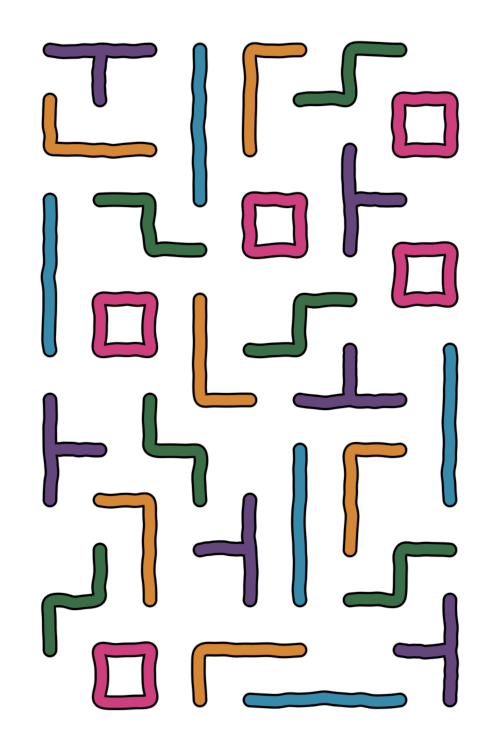
The concept for Wedged is “playing Tetris optimally badly”. Badly in that no row is complete, and optimally in that each row has at most one empty cell, and the rectangle is filled. Additional aesthetic constraints are encoded in the source code to generate more pleasing images.
Starting from an empty rectangle, block off one cell in each row, subject to the constraint that blocked cells in nearby rows shouldn’t be too close to each other, and the blocked cells should be roughly evenly distributed between columns. Some of these blockings might be duplicates (taking into account mirroring and rotation), so pick only one from each equivalence class.
Starting from the top left empty cell in each of these boards, fill it with pieces that fit. Fitting means that the piece is entirely within the board, not overlapping any blocked cells or other pieces. There are some additional constraints to improve aesthetic appearance and reduce the number of output images: there should not be too many pieces of the same colour in the board, all adjacent pieces should be a different colour, and no piece should be able to slide into the space left when blocked cells are removed (this applies only to the long thin blue pieces, the other pieces can’t move due to the earlier constraint on nearby blocked cells).
The filling process has some other aesthetic constraints: the board must be diverse (there must be a wide range of distinct colours in each row and column), the complete board must have a roughly even number of pieces of each colour, and there shouldn’t be any long straight line boundaries between multiple pieces. The complete boards might have duplicates under symmetries (in the case that the original blocking arrangement was symmetrical), so pick only one from each equivalence class.
Dynamo (2011)
Sound installation
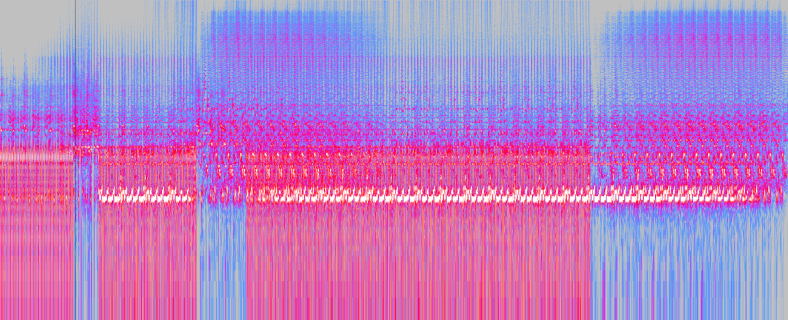
Generative techno. Dynamo creates music from carefully controlled randomness, using numbers to invent harmonies, melodies, and rhythms. Dynamo is a Pure-data patch which plays new techno tracks forever. It is a generative system, and not a DJ mix.
When it is time to generate a new track, Dynamo first picks some high level parameters like tempo, density, and the scale of notes to use. Then it fills in the details, such as the specific rhythms of each instrument and which notes to play in which order. Finally an overall sequence is applied to form the large scale musical structure.
Pure-data is deterministic, which makes Dynamo deterministic. To avoid the same output each time the patch is started, entropy is injected from outside the Pure-data environment.
Puzzle (2008-2019)
Audio-visual installation
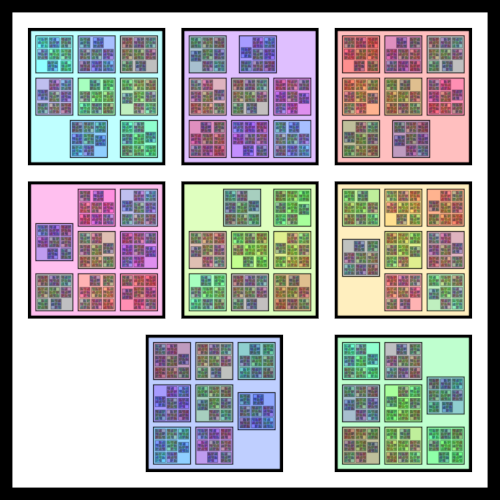
Sliding tile puzzles have existed for over a century. The 15-puzzle craze in 1880 offered a cash prize for a problem with no solution. In the Puzzle presented here the computer is manipulating the tiles. No malicious design, but insufficient specification means that no solution can be found; the automaton forever explores the state space but finds every way to position the tiles as good as the last…
Each tile makes a sound, and each possible position has a processing effect associated with it. Part of the Puzzle is to watch and listen carefully, to see and hear and try to pick apart what it is that the computer is doing, to reverse-engineer the machinery inside from its outward appearance. The video is built using eight squares, each coloured tile is textured with the whole Puzzle, descending into an infinite fractal cascade. The control algorithm is a Markov Chain that avoids repetition.
Puzzle is implemented in Pure-data, using GEM for video and pdlua for the tile-control logic.
GraphGrow (2007-2019)
Interactive installation
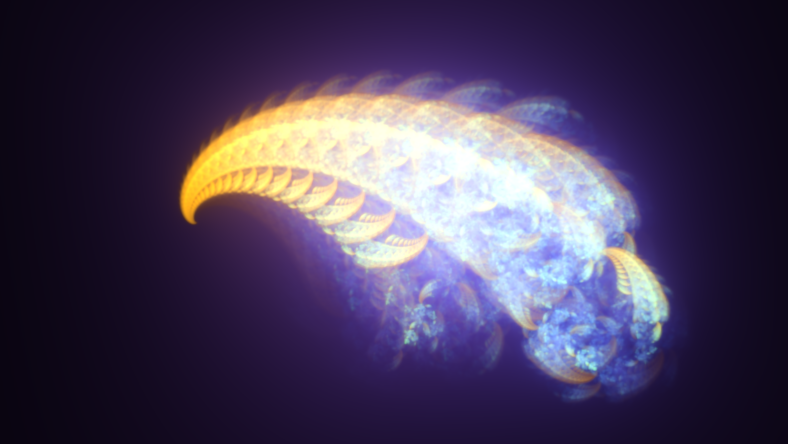
A graph is a set of nodes and links between them. In GraphGrow the term is overloaded: there are visible graphs of nodes and links on the tablet computer, and a second implicit graph with links between the rules.
The visible graphs give the name of GraphGrow - a fractal is grown from a seed graph by replacing each visible link with its corresponding rule graph, recursively. The correspondence is by colour: a yellow link corresponds to the graph with yellow background, and so on. The implicit graph between rules thus directs the expansion. The implict graph is also a directed graph (even more terminological overloading!).
The rule graphs are constrained, with two fixed nodes at left and right. When growing a graph, each link is replaced with the corresponding rule graph with the left-hand fixed node of the rule mapped to the start point of the link and the right-hand fixed node of the rule mapped to the end point of the link. The mapping is restricted to uniform scaling, rotation and translation. The fixed nodes are coloured white on the tablet.
The fractal is projected, along with rhythmic drones amplified through speakers. Both are generated from the graph data. Dragging the brightly coloured nodes on the tablet in each of the four rule graphs, allows the gallery visitor to explore a subspace of graph-directed iterated function system of similarities.
Hybrids (2018-2019)
Video installation
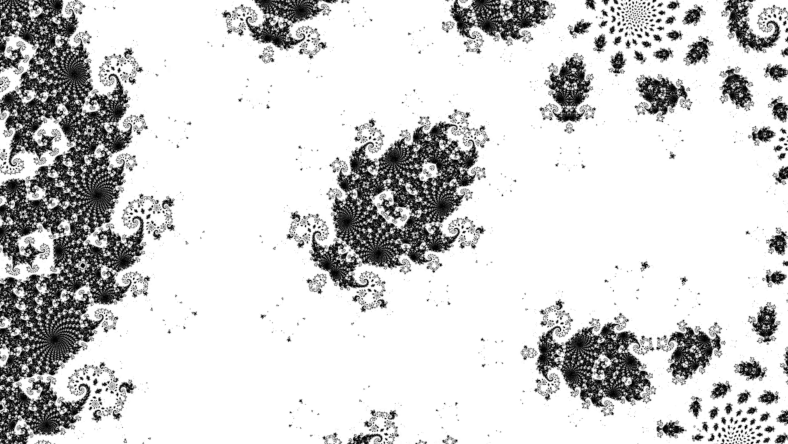
Fractals are mathematical objects exhibiting detail at all scales. Escape-time fractals are plotted by iterating recurrence relations parameterised by pixel coordinates from a seed value until the values exceed an escape radius or until an arbitrary limit on iteration count is reached (this is to ensure termination, as some pixels may not escape at all). The colour of each pixel is determined by the distance of the point from the fractal structure: pixels near the fractal are coloured black and pixels far from the fractal are coloured white, or the reverse.
Escape-time fractals are generated by formulas, for example the Mandelbrot set emerges from z → z2 + c and the Burning Ship emerges from x + iy → (|x| + i|y|)2 + c, where c is the coordinates of each pixel. Hybrid fractals combine different formulas into one more complicated formula: for example one might perform one iteration of the Mandelbrot set formula, then one iteration of the Burning Ship formula, then two more iterations of the Mandelbrot set formula, repeating this sequence in a loop.
Artist Biography
Claude Heiland-Allen is an artist from London interested in the complex emergent behaviour of simple systems, unusual geometries, and mathematical aesthetics.
From 2005 through 2011 Claude was a member of the GOTO10 collective, whose mission was to promote Free/Libre Open Source Software in Art. GOTO10 projects included the make art Festival (Poitiers, France), the Puredyne GNU/Linux distribution, and the GOSUB10 netlabel. Since 2011 he has continued as an unaffiliated independent artist and researcher.
Claude has performed, exhibited and presented internationally, including in the United Kingdom (London, Cambridge, Winchester, Lancaster, Oxford, Sheffield), the Netherlands (Leiden, Amsterdam), Austria (Linz, Graz), Germany (Cologne, Berlin), France (Toulouse, Poitiers, Paris), Spain (Gijon), Norway (Bergen), Slovenia (Maribor), Finland (Helsinki), and Canada (Montreal).
Claude’s larger artistic projects include RDEX (an exploration of digitally simulated reaction diffusion chemistry) and clive (a minimal environment for live-coding audio in the C programming language). As a software developer, Claude has developed several programs and libraries used by the wider free software community, including pdlua (extending the Puredata multimedia environment with the Lua programming language), buildtorrent (a program to create .torrent files), and hp2pretty (a program to graph Haskell heap profiling output).
